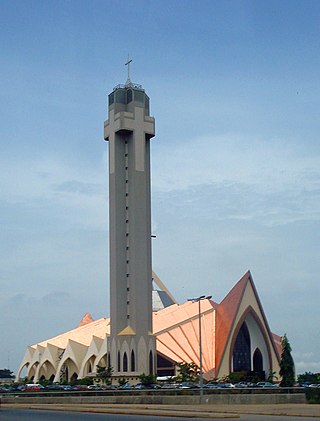Related Research Articles

The Church of the Holy Sepulchre, also known as the Church of the Resurrection, is a fourth-century church in the Christian Quarter of the Old City of Jerusalem. The church is also the seat of the Greek Orthodox Patriarchate of Jerusalem. Some consider it the holiest site in Christianity and it has been an important pilgrimage site for Christians since the fourth century.

Nazareth is the largest city in the Northern District of Israel. In 2022 its population was 78,007. Known as "the Arab capital of Israel", Nazareth serves as a cultural, political, religious, economic and commercial center for the Arab citizens of Israel. The inhabitants are predominantly Arab citizens of Israel, of whom 69% are Muslim and 31% Christian. The city also commands immense religious significance, deriving from its status as the hometown of Jesus, the central figure of Christianity and a prophet in Islam.

In Islam, Jesus is believed to be the penultimate prophet and messenger of God and the Messiah sent to guide the Children of Israel with a book called the Injīl.

Ahmadiyya considers Jesus (ʿĪsā) as a mortal man, entirely human, and a prophet of God born to the Virgin Mary (Maryam). Jesus is understood to have survived the crucifixion based on the account of the canonical Gospels, the Qurʾān, hadith literature, and revelations to Mirza Ghulam Ahmad. Having delivered his message to the Israelites in Judea, Jesus is understood to have emigrated eastward to escape persecution from Judea and to have further spread his message to the Lost Tribes of Israel. In Ahmadiyya Islam, Jesus is thought to have died a natural death in India. Jesus lived to old age and later died in Srinagar, Kashmir, and his tomb is presently located at the Roza Bal shrine.
Religion in Singapore is characterised by a wide variety of religious beliefs and practices due to its diverse ethnic mix of people originating from various parts of the world. A secular state, Singapore is commonly termed as a "melting pot" or "cultural mosaic " of various religious practices originating from different religions and religious denominations around the world. Most major religious denominations are present in the country, with the Singapore-based Inter-Religious Organisation recognising 10 major religions. A 2014 analysis by the Pew Research Center found Singapore to be the world's most religiously diverse nation.

Maryam bint Imran holds a singularly exalted place in Islam. The Qur'an refers to her seventy times and explicitly identifies her as the greatest woman to have ever lived. Moreover, she is the only woman named in the Quran. In the Quran, her story is related in three Meccan surahs and four Medinan surahs. The nineteenth Surah, Maryam, is named after her.

The Chora Church or Kariye Mosque is a former church, now converted to a mosque, in the Edirnekapı neighborhood of Fatih district, Istanbul, Turkey. It is mainly famous for its outstanding Late Byzantine mosaics and frescos.

Christianity and Islam are the two main religions practiced in Nigeria. The country is home to some of the world's largest Christian and Muslim populations, simultaneously. Reliable recent statistics do not exist; however, Nigeria is divided roughly in half between Muslims, who live mostly in the northern region, and Christians, who live mostly in the southern region of the country. Indigenous religions, such as those native to the Igbo and Yoruba ethnicities, have been declining for decades and being replaced by Christianity or Islam. The Christian share of Nigeria's population is also now on the decline, due to a lower fertility rate relative to the Muslim population in the country.

The Roza Bal, Rouza Bal, or Rozabal is a shrine located in the Khanyar quarter in downtown area of Srinagar in Kashmir, India. The word roza means tomb, the word bal means place. Locals believe a sage is buried here, Yuz Asaf, alongside another Muslim holy man, Mir Sayyid Naseeruddin.

The Anglican Church of Kenya (ACK) is a province of the Anglican Communion, and it is composed by 41 dioceses. The current Leader and Archbishop of Kenya is Jackson Ole Sapit. The Anglican Church of Kenya claims 5 million total members. According to a study published in the Journal of Anglican Studies and by Cambridge University Press, the ACK claims 5 million adherents, with no official definition of membership, with nearly 2 million officially affiliated members, and 310,000 active baptised members. The church became part of the Province of East Africa in 1960, but Kenya and Tanzania were divided into separate provinces in 1970.

Christianity in Africa arrived in the 1st century AD, and in the 21st century it is the largest religion on the continent. Several African Christians influenced the early development of Christianity and shaped its doctrines, including Tertullian, Perpetua, Felicity, Clement of Alexandria, Origen of Alexandria, Cyprian, Athanasius and Augustine of Hippo. In the 4th century, the Aksumite empire in modern-day Ethiopia and Eritrea became one of the first regions in the world to adopt Christianity as its official religion, followed by the Nubian kingdoms of Nobatia, Makuria and Alodia and several Christian Berber kingdoms.

Christianity is the dominant religion in Kenya, adhered to by an estimated 85.5% of the total population. Islam is the second largest religion in Kenya, practiced by 10.9 percent of Kenyans. Other faiths practiced in Kenya are Baháʼí, Buddhism, Hinduism and traditional religions.
Kerugoya is the largest town in Kirinyaga County, located 10 kilometres east of Karatina and 40 kilometres west of Embu. It is situated in the former Kirinyaga district. Travel directions by road from Nairobi is through Thika Road past Thika, Kenol and Makuyu. The road leads through Makutano until Sagana town, where a road branches off the East towards Kagio town up to Kirinyaga University branching North towards the town.

Religion in Colombia is dominated by various branches of Christianity and is an expression of the different influences in the Colombian culture including the Spanish, the Native Amerindian and the Afro-Colombian, among others.

Christianity is the official and largest religion in Samoa, with its various denominations accounting for around 98% of the total population. The article 1 of the Constitution of Samoa states that "Samoa is a Christian nation founded of God the Father, the Son and the Holy Spirit".

Ahmadiyya, officially the Ahmadiyya Muslim Jama'at (AMJ), is an Islamic messianic movement originating in British India in the late 19th century. It was founded by Mirza Ghulam Ahmad (1835–1908), who said he had been divinely appointed as both the Promised Mahdi and Messiah expected by Muslims to appear towards the end times and bring about, by peaceful means, the final triumph of Islam; as well as to embody, in this capacity, the expected eschatological figure of other major religious traditions. Adherents of the Ahmadiyya—a term adopted expressly in reference to Muhammad's alternative name Ahmad—are known as Ahmadi Muslims or simply Ahmadis.

Syedna Mufaddal Saifuddin is the spiritual leader, the 53rd Da'i al-Mutlaq of one million Dawoodi Bohras, a subgroup of the Tayyibi, Mustaali, Ismaili Shia branch of Islam. He is the second son of the 52nd Da'i al-Mutlaq, Mohammed Burhanuddin, whom he succeeded in 2014. He is the Chancellor of Aligarh Muslim University and Jamia Millia Islamia situated in India. He has led a number of cultural, social, and economic initiatives. In Islamic Cairo, he rebuilt shrines of the Ahl al-Bayt and led the restoration of medieval Fatimid architecture, notably Al-Anwar Mosque, Al-Aqmar Mosque, Al-Juyushi Mosque, and Lulua Mosque. In Yemen, he has spearheaded several campaigns to improve socio-economic conditions of the inhabitants of the Haraaz region, introducing sustainable agricultural systems, improving local infrastructure and providing equal access to education for children.

Pavlo Serhiyovych Lapshyn is a Ukrainian white supremacist terrorist who committed crimes in 2013 against Muslims in the United Kingdom. Lapshyn was given a life sentence, and will serve a minimum of 40 years, for a murder in Birmingham and three attempted bombings of mosques in the West Midlands. He confessed to police that his motivation was to kill and harm non-whites.

Thomas Gerard Catena is an American physician who has been practising in Gidel in the Nuba Mountains of Sudan since 2008. On May 28, 2017, he was awarded the second annual Aurora Prize for Awakening Humanity, receiving a $100,000 grant and an additional one million dollars for him to distribute to three humanitarian organizations. He has been likened to the 20th-century medical missionary Albert Schweitzer. The New York Times has published instructions on how to donate to Catena. In 2018, Dr. Catena was appointed Chair of the Aurora Humanitarian Initiative.
The Anglican dioceses of Mount Kenya are the Anglican presence in east-central, north and north-east Kenya; they are part of the Anglican Church of Kenya. The remaining dioceses of the Church area in the areas of Mombasa, of Maseno, and of Nakuru.
References
- ↑ Odhiambo, Harold (13 December 2020). "'Mosque of Jesus Christ' causes online sensation". The Standard. Retrieved 28 October 2021.
- ↑ Wanjohi, John (13 December 2020). "Kenyan Mosque Named 'Jesus Christ Son of Mary' Causes a Stir Online". Mwakilishi. Retrieved 28 October 2021.
- 1 2 Munene, George (12 July 2021). "Kenya: Joy as Kirinyaga Muslims Get New Sh15 Million Mosque". All Africa. Retrieved 28 October 2021.
- ↑ Lisimba, Hillaly (14 July 2021). "Muslims of Kirinyaga West Finally Get Mosque after Many Years". Tuko. Retrieved 28 October 2021.